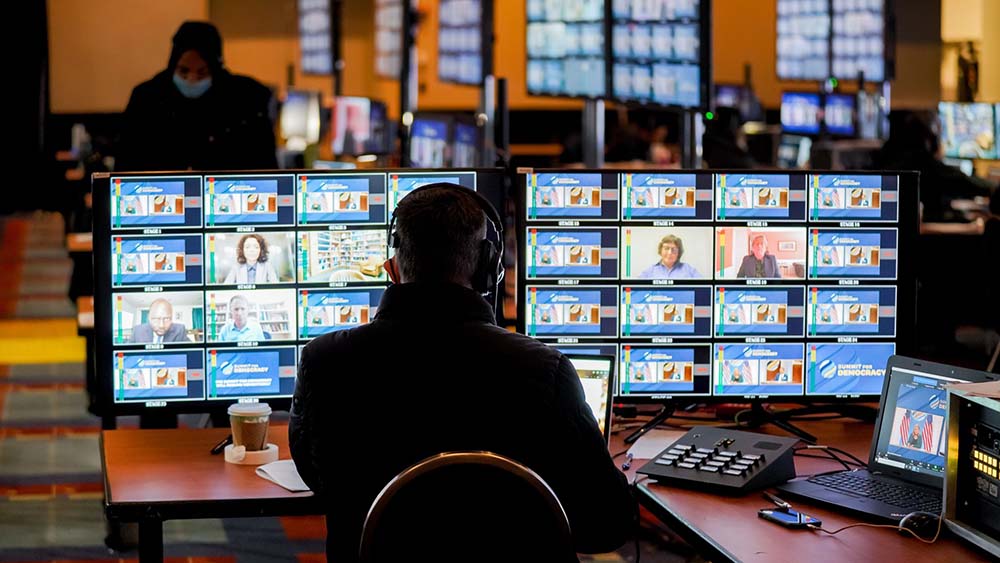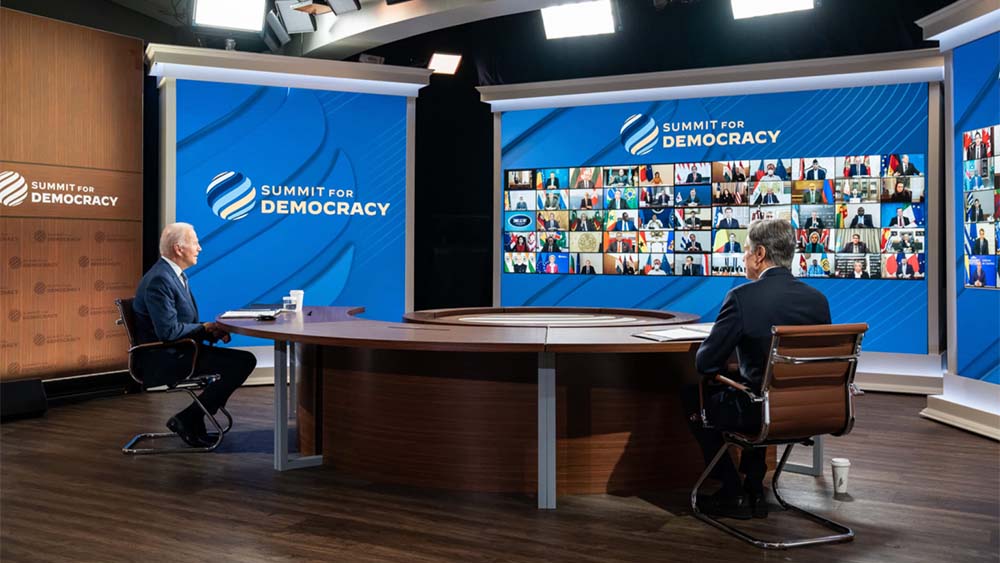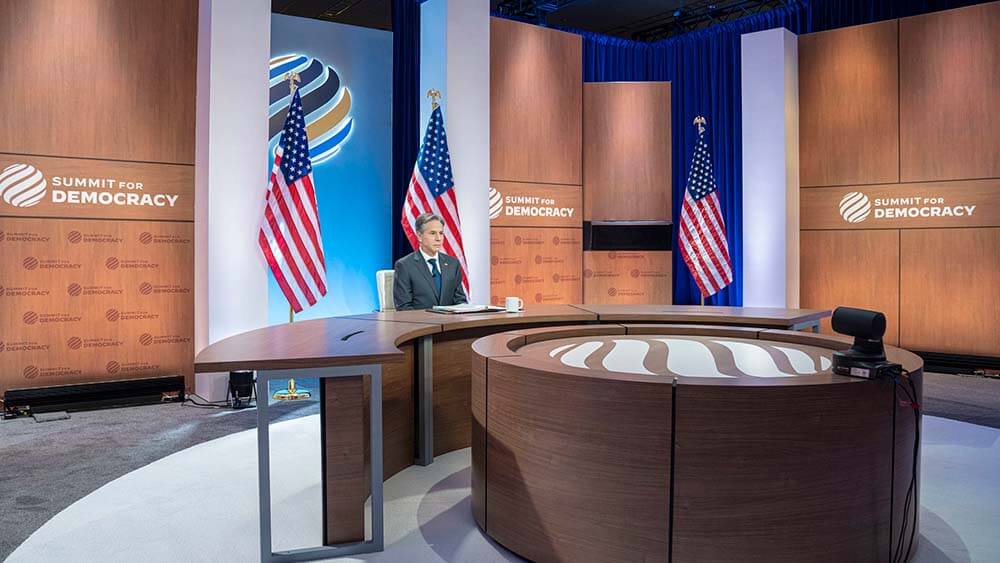
When the Summit for Democracy moved to an online ‘complementary’ event, Freeman had to find a way to bring 100-plus world leaders across 22 times zones together virtually. (Courtesy Freeman)
Mike Wohlitz, senior vice president of design and delivery for Freeman, is accustomed to producing high-profile events with his team — a steady stream of “Super Bowls and Olympics and amazing conventions for heart surgeons, scientists, and educators,” Wohlitz told Convene. “Like a lot of us in the industry, we get jaded.” But producing last December’s Summit for Democracy, which convened 111 heads of state from around the globe to talk about protecting democracy in the free world, was a “once-in-a-lifetime opportunity,” which was “really at higher level,” he said.
In addition to world leaders, Wohlitz and his team worked with ambassadors, U.S. Cabinet members, Nobel Peace Prize winners, and others to produce the summit created by President Joe Biden’s administration. The mission of the event was to strengthen democracy and defend against authoritarianism, addressing corruption and promoting respect for human rights around the world. There’s “an importance and relevance and honor,” to producing an event with that scope and ambition, Wohlitz said.
The honor also came with challenges: When planning began in March 2021, “the intention was that it be an in-person event,” Wohlitz said. But by mid-August, organizers had decided to move the event online in response to the spread of COVID-19 Delta variant, he said. “It was quite a scramble from Labor Day on.”
The already complex undertaking of bringing 100-plus world leaders together to talk to one another is made especially tricky, he said, “when you’re trying to do it on the backbone of a virtual event. How do you talk about something that’s so critical to the human spirit when we’re separated across 22 time zones around the world?” A driving factor in designing the event, he said, became answering the question: “How do we make it feel as if we’re all in the room?”
One answer was to create a unifying visual aesthetic — Freeman built a studio in the Eisenhower Executive Office building on the White House grounds, where President Biden and Vice President Kamala Harris spoke, and three more studios at the Walter E. Washington Convention Center, less than a mile-and-a-half away. The event was broadcast to the world from the convention center, including content originating at the White House, which was sent by secure fiber lines from the White House to the convention center, Wohlitz said. “It was quite an impressive infrastructure, literally buried under the streets of Washington, D.C.”

President Biden (left) addresses world leader from a studio built in the Eisenhower Executive Office building on the White House grounds for the Summit for Democracy. The world leaders appeared remotely on LED screens within the studio. (Courtesy the White House)
Maintaining Viewer Interest
Another challenge was creating engagement for viewers. “Virtual events can be very stale if you treat them as just another Zoom meeting — especially in this case, where that Zoom meeting might be 10 hours a day for three days in a row,” Wohlitz said. “There is absolutely a broadcast art form to it to keep it intriguing, different, fresh, and invigorating.”
One of the resources that Wohlitz drew from was his own and other team members’ experience in producing talk shows. The summit’s production designer was Dustin Efird — both men worked for Harpo Productions, which produced Oprah Winfrey’s top-rated, long-running talk show. “No one knows how to make you more comfortable in a conversation than Miss Winfrey,” Wohlitz said.
The production design “was relevant to a talk-show type of environment,” he said. “And then we added different camera feeds.”
The studio featured a semicircular table, where two speakers could look at one another and at the camera. A wall of LED screens allowed remote panelists to appear on the screen alongside the speakers in the studio. There was an element of decorum to the event, “so we couldn’t go as fancy as you might on some television shows,” Wohlitz said, “But we always tried to add different interesting shots, instead of just shooting someone head on.” For example, the camera might shoot from behind the shoulder of the moderator, so viewers could see the interactions with the virtual panelists from the moderator’s point of view. “Visually, we’ve got people having a human conversation, despite the fact that there’s a whole bunch of computers behind the screen, connecting it all.”
Wohlitz also added professionals with sports broadcasting experience to the production team. “We needed people who could think quickly on their feet and respond and interact in the conversations with government officials,” Wohlitz said. “There’s no script. We have a topic and then people talk for an hour. What happens next is often unknown, much like a sporting event — we know that they’re going to kick the football off at 12 noon, but what happens for the next three hours in a sporting event, we don’t know until it’s done.”
One of the nuances that some people miss in virtual events is that the goal is not just capturing what is being said, “but making it look intriguing on a computer screen,” Wohlitz said. Looking back on how virtual events used to be produced, “we took the feeds that would’ve gone to the screens in a general session room, and we streamed it to a website so people could watch it,” he said. “That’s not very compelling, because that camera shot is not meant to intrigue someone watching on a computer screen at all. That camera shot was intended to allow the person who is 15,000-people deep, in the back of the general session hall, to be able to see the speaker. So, there’s an art form in how you treat this.”

Secretary of State Antony J. Blinken participates in a virtual discussion with young democratic leaders from around the world as part of the Summit for Democracy. (State Department photo by Freddie Everett)
‘Complementary Events’
Wohlitz’s uses the term “complementary” to describe events that blend both live and digital audiences. “I think the future of these complementary events is you’re creating two different broadcasts, one for the live audience and one for the virtual audience. We can do it using in the same hardware — it just takes a different approach in thinking and methodology to how you broadcast that in a compelling way.”
Based on his experience producing the Summit, “I suspect that the future of international summits will be to have both an in-person and virtual element to it,” Wohlitz said. World leaders have extraordinarily complicated calendars, and digital platforms allow them to participate for “a few hours a day, versus a week’s worth of time to have to travel all the way around the world,” he said. “It’s still important for these summits that heads of state be there face-to-face, but those who present other topics could continue to join [via a] virtual environment. So that’s one side — we enlarge the number of participants, including those who can’t travel in.”
The other side is that it “really is an extraordinary broadcast platform for the rest of the world,” Wohlitz said. “Almost all work we produced was openly shared with the rest of the world — these were not closed-door sessions. And so the world could watch on YouTube or Vimeo by logging into the State Department website and see democracy at work.”
Speaking of democracy, one of the takeaways for Wohlitz was a heightened awareness of how many things we take for granted in the U.S., he said. “On a very personal level, we got to meet some people with struggles that we can’t even envision — just basic rights for women … for voting, the right to free speech. The things that we take for granted are an exception in a lot of the world.”
Barbara Palmer is deputy editor at Convene.
